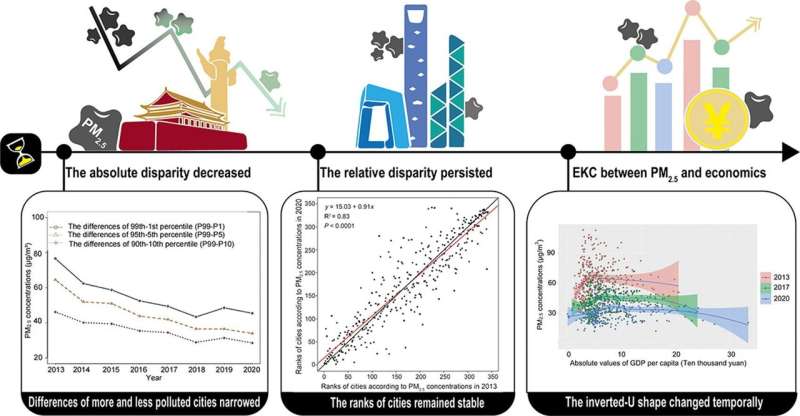This article has been reviewed according to Science X's editorial process and policies. Editors have highlighted the following attributes while ensuring the content's credibility:
fact-checked
proofread
Reducing PM2.5 disparity in China: Progress and challenges

A pivotal study, published in Eco-Environment & Health, has examined the evolution of PM2.5 pollution disparity in China from 2013 to 2020, revealing both progress and persistent challenges in air quality management.
This study used high-resolution data to analyze the temporal trends of the spatial disparity in PM2.5 concentrations and their relationship with economic factors across China from 2013 to 2020. The difference in PM2.5 between highly and less polluted areas decreased, indicating that the absolute disparity decreased over time. However, cities with high PM2.5 levels in 2013 remained heavily polluted in 2020, and vice versa, suggesting that the relative disparity persisted.
The study also found an inverted U-shaped relationship between PM2.5 levels and economic development in China. Overall, economic growth initially worsens air quality before potentially leading to improvement once a certain threshold is reached. The negative effects in less-developed regions tended to diminish over time, and economic development tended to promote cleaner air in developed areas of China. This finding aligns with the Environmental Kuznets Curve theory.
The study's lead researcher, Dr. Xia Meng, highlighted the importance of understanding PM2.5 disparities to inform targeted air quality improvement strategies and promote environmental equality.
This research provides critical insights for policymakers to develop nuanced strategies that address both economic growth and environmental protection. It underscores the need for region-specific air quality policies. The study marks a significant step in understanding the dynamics of PM2.5 pollution in China and sets a foundation for future efforts to achieve environmental justice and health equity.
More information: Su Shi et al, Evolution in disparity of PM2.5 pollution in China, Eco-Environment & Health (2023). DOI: 10.1016/j.eehl.2023.08.007
Provided by TranSpread




















